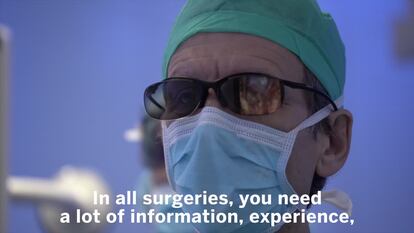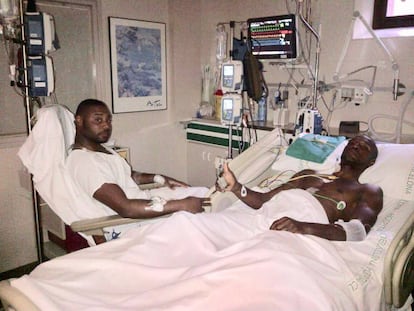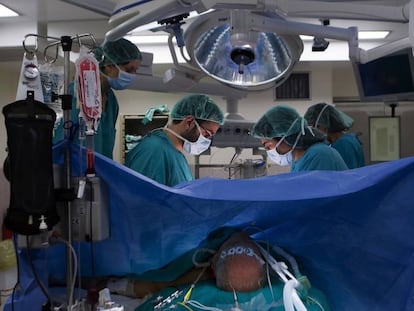Video: How robots are revolutionizing kidney transplants in Spain
Watch Spanish surgeons and an electronic assistant named Da Vinci successfully extract an organ from a live donor at Hospital Clínic de Barcelona
An intermittent beep marks the rhythm in the operating room. There is no music and no one is speaking. Only a high-pitched tone of the vital signs monitor breaks the silence. It’s 9.30am. On the operating table, a woman is already under anesthesia. Around her, a dozen doctors move in an orderly chaos – the operation has begun. The technical term for it is nephrectomy, but colloquially it is known as a kidney transplant. The woman is the donor, and the recipient is her son.
A surgeon must have the heart of a lion, the eyes of an eagle and the hands of a woman
Head surgeon Antonio Alcaraz
“I have no doubt that everything will go well. We are that pedantic,” says Antonio Alcaraz, head of the urology department at the Hospital Clínic de Barcelona and the surgeon in charge of the operation. The hospital is Spain’s leader in live donor kidney transplants (in 2018, it did 40 of the total 293) and Alcaraz is the surgeon with the most operations under his belt: 1,400 as head surgeon and 400 as part of a surgical team.
In the operating room, Doctor Lluís Peri begins. He has made three small incisions on the patient’s side so that he can insert a laparoscopy, a medical instrument that is operated from the outside and works within the body like the hands of a surgeon. The hospital has been using this less-invasive technique since 2002 to reduce the risk of infection. “Surgeons do not like blood,” laughs Alcaraz. With an electric scissor, which cuts and cauterizes at the same time, Peri makes his way toward the kidney.
Alcaraz’s operating room is not like one you see in the movies. There isn’t music, or personal spats or arguments between doctors. “The operating room is not a democracy. You do what the surgeon in charge says,” explains Alcaraz. However, there are times to relax and chat. “Viva España,” says Alcaraz. “Visca Catalunya,” responds Peri jokingly, by cheering for Catalonia. In complicated situations, the room becomes tense, the team is silent and holds its breath. “A surgeon must have the heart of a lion, the eyes of an eagle and the hands of a woman. You have to be mentally strong, skillful and show that your brain knows how to control your nerves,” says Alcaraz.
Transplants in numbers
Spain, a global leader. In 2018, 48 people per one million inhabitants were organ donors, according to the National Organization of Transplants (ONT). Spain has been the leader for the past 27 years, only two years after the ONT was founded.
Almost three transplants per donor. In 2018, a record 2,241 donations were made, allowing 5,316 organ transplants to be performed.
Transplant hospitals. From the almost 800 hospitals in Spain, 185 are authorized to manage donations, while 44 can carry out transplants.
The kidney, the most transplanted organ. Since 1989, 72,166 kidney transplants, 27,282 liver transplants and 8,534 heart transplants have been performed.
Shorter waiting list. In 2018, 4,804 people were on the waiting list for a transplant, including 88 children.
Alcaraz takes the laparoscopic joysticks (two of the arms form the tweezers and scissors and the third is a camera that reproduces the image in three dimensions on the monitors), puts on his 3D glasses and starts moving through the cavity. “Look at the aorta.” A large gelatinous tube appears on the monitor. The surgeon separates the renal vessels and the ureter to see better. “This already looks more like what you see in the books,” he says.
Now comes the difficult part: the vessels that connect the kidney to the bloodstream have to be cut. Alcazar cuts the veins and and renal arteries and starts the timer. Once it is cut from the bloodstream, it must be placed on ice in preservation fluid as soon as possible. Peri makes an incision at the patient’s navel and Alcaraz puts his hand through it to reach the kidney. On the screen, a white glove gently grasps the organ. He extracts it, places it on an ice tray and asks: “Time?” “2.57,” someone answers. “We have taken three minutes. Before it was pinker and now it is grayish.”
While Peri closes and sews, Alcaraz removes the fat from the kidney, seals its capillaries and cleans up the entrance to the artery and vein. He then places the kidney on an ice tray. The anesthesia wears off and the donor wakes up. On the way out, she crosses paths with her son, who is waiting in an adjoining room.
At midday, the surgeons begin prepping for the second operation. The patient is already asleep. Over the stretcher, the robot called Da Vinci, which has four arms like those of a spider, says: “Da Vinci is ready.” Robotic transplants have been performed at the hospital since 2015. It is a very clean and simple technique: small incisions are made in a patient's side to allow the robot’s arms to enter, and a small cut so the organ can be placed inside.
The kidney, in its ice tray, is inserted into the patient’s stomach. Alcaraz controls the robot’s movements on a monitor a few meters away from the patient. He isolates the iliac vein from the circulation and makes a tiny cut in the vessel in order to sew it to the renal vein. Heparin (an anticoagulant) is injected into the hole to prevent clots. Alcaraz then begins to stitch up the veins and arteries. He then removes the mesh that isolated them from circulation, and blood begins to flow again. The ureter, which is still loose, beings to urinate. This is a good sign and means that the kidney is working. Alcaraz takes off his gloves and leaves.
“We must promote donation as another activity within the ICU”
From his office in Geneva, Dr José Ramón Núñez monitors transplants around the world. He is responsible for the WHO Donation and Transplant Program. He was recently visiting Barcelona to take part in a session organized by the Catalan Transplant Organization.
Question: "What is it about Spanish system that makes it receive so much praise?
Answer: Good organization and a public system, which is fair and free. People are equally generous around the world, but when they detect a lack of fairness, they become wary.
Q: Spain has become a leader in transplants and donations. Is there still room for improvement?
A: You have to identify 100% of potential donors and among the people admitted to the Intensive Care Unit (ICU), donation should be considered a right. We must promote donation as another activity within the ICU.
Q. What happens in other countries?
A. There are 124 countries, and the realities are completely different. But as soon as the Spanish model is applied anywhere in the world, donations rise dramatically. Although it is true that there are differing social and professional realities which make transplants harder. For example, in India, the standard for brain death – the patient is dead but his heart still beating – is not shared by professionals. In Africa, transplant programs are considered a utopia, because their priority is stopping women from dying in childbirth, children from dying at birth, from contracting malaria. It comes down to the health conditions of these countries. Spain's free healthcare does not exist anywhere else.
Q. When you up took office in the WHO, you undertook the mission to combat organ trafficking. How is it going?
A. Organ trafficking generates $1 billion a year. When we try to stop it in one part of the world, it just moves to another. We are making an effort to detect it, but my priority is to increase legal transplants in order to reduce illegal trafficking.
English version by Asia London Palomba.
Tu suscripción se está usando en otro dispositivo
¿Quieres añadir otro usuario a tu suscripción?
Si continúas leyendo en este dispositivo, no se podrá leer en el otro.
FlechaTu suscripción se está usando en otro dispositivo y solo puedes acceder a EL PAÍS desde un dispositivo a la vez.
Si quieres compartir tu cuenta, cambia tu suscripción a la modalidad Premium, así podrás añadir otro usuario. Cada uno accederá con su propia cuenta de email, lo que os permitirá personalizar vuestra experiencia en EL PAÍS.
¿Tienes una suscripción de empresa? Accede aquí para contratar más cuentas.
En el caso de no saber quién está usando tu cuenta, te recomendamos cambiar tu contraseña aquí.
Si decides continuar compartiendo tu cuenta, este mensaje se mostrará en tu dispositivo y en el de la otra persona que está usando tu cuenta de forma indefinida, afectando a tu experiencia de lectura. Puedes consultar aquí los términos y condiciones de la suscripción digital.
More information
Archived In
Últimas noticias
Chris Martin, Taylor Swift, Elijah Wood and other famous wedding ‘crashers’
‘How does it feel to be a failure?’: Elizabeth Berkley’s journey from ‘Showgirls’ ridicule to vindication
The story of the Málaga virus: The code that haunted Google’s cybersecurity center director for 30 years
The impact of Ecuador’s mega-prison: A polluted river, cleared forests and military checkpoints
Most viewed
- Christian Louboutin: ‘Young people don’t want to be like their parents. And if their parents wear sneakers, they’re going to look for something else’
- The low-cost creative revolution: How technology is making art accessible to everyone
- Liset Menéndez de la Prida, neuroscientist: ‘It’s not normal to constantly seek pleasure; it’s important to be bored, to be calm’
- All the effects of gentrification in one corner of Mexico’s Colonia Roma
- December Social Security and SSI payments: Dates, double checks and the 2026 COLA increase












































